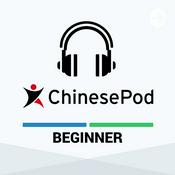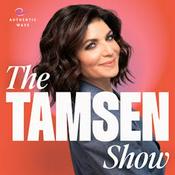66 episodes

The Truth About Boundaries: Why They're Hard and How to Hold Them
23/12/2025 | 59 mins.
She explores the difference between embodied boundaries and self-protective boundaries, which form as a result of unmet needs and misattunement in childhood. You’ll learn how to reconnect with your adult self, identify the protective parts that might be informing the way you set limits, and communicate your needs without reverting to old patterns.Through practical guidance and compassionate teaching, Sarah offers a path back to boundaries that reflect who we are now, not who we once had to be. Tune in to hear how a somatic approach can support healing, authenticity, and deeper connection! Episode Highlights:[00:00] Introduction[01:10] Why family dynamics pull us back into younger roles[04:48] How early nervous system development shapes regulation[06:50] The importance of honoring a child’s boundaries[11:16] Ways that childhood boundary violations impact adult patterns[15:50] The 3 boundary styles: diffuse, rigid, and embodied[21:45] Learning to anchor in the adult self around family of origin[26:23] Preparing for resistance when shifting long-term dynamics[28:50] Working with protective parts who fear boundary setting[32:34] What to expect from internal and external resistance[37:06] Leading with the adult self when communicating boundaries[39:34] Applying embodied boundaries in family and holiday settings[42:27] Question 1: Staying regulated when younger parts panic[45:54] Question 2: Naming needs in relationships when anxious attachment shows up[51:24] Question 3: Navigating boundaries with unsafe or traumatic family systems Join the Waitlist for Navigating Your Nervous System:Living a full, expansive life starts with nervous system regulation. If you’re looking for practical tools and support on your healing journey, you can now get on the waitlist for my upcoming 6-week LIVE program. Everyone on the waitlist receives access to limited-time pricing:https://bit.ly/sp-nyns-waitlist Download Sarah’s FREE Workbook:Not sure where to get started with somatic healing? Sarah created a FREE trauma-informed workbook called "How To Gain Control Over How You Feel" to help you step toward a life filled with more freedom, ease, and empowerment. Click the link below to download the workbook:https://bit.ly/yms-sp-workbook Connect with Sarah on:Email Community - bit.ly/yms-sp-newsletterInstagram — instagram.com/sarahbcoachingWebsite — sarahbaldwincoaching.com Submit a Question:sarahbaldwin1.typeform.com/podcast Quotes:“[Setting boundaries] is what allows us to navigate life as our authentic self. And this is also what allows us to navigate life in a way that gets our needs met in a multitude of ways. So it is really vital that we are able to come into this experience.” — Sarah Baldwin [0:10:40]“Even with loving parents, most of them did not know how to parent, and that meant that they didn't realize the imperative nature of honoring and validating your embodied boundary.” — Sarah Baldwin [0:11:27]“Whatever we need to do that makes it tolerable to set the boundary, that's what we want to focus on.” — Sarah Baldwin [0:32:29]“The more that you're doing parts work on a regular basis, the more these parts are going to trust you as you begin setting these boundaries. [It’s] really important that we're engaging in that regularly.” — Sarah Baldwin [0:36:55]“[When you’re] re-parenting [your parts], what actually happens is you become the parent they never had. You become their home internally. And now the parts are no longer looking for your caregivers to be their mom and dad.” — Sarah Baldwin [0:54:24]“Accessing our ability to set healthy boundaries is good. It is a gift for everyone. It's an invitation to them into their own healing, and it's not our business whether they take the invitation or not. So how do we do this? As always, one tolerable step at a time.” — Sarah Baldwin [0:58:39]

The Secret to Actually Loving Yourself: Falling in Love with Your Younger Parts
16/12/2025 | 1h 4 mins.
You’ll learn about the importance of consistency in reparenting your parts, why this process is about relationship-building, and how to find love for the protective parts of you that are often responsible for challenging behaviors or patterns. When you do this work, without having an agenda, it’s possible to feel self-love in a way that lasts and transforms every area of your life. Episode Highlights:[00:00] Introduction[01:12] You can’t “talk” yourself into self-love[05:00] An overview of Parts Work (Internal Family Systems)[12:37] An explanation of how to reparent your younger parts[19:15] The importance of building trust with your parts[21:39] Loving both your vulnerable and protective parts[35:31] The integration process and making your parts whole with you[38:26] Question 1: Deciphering if choices come from truth or trauma[49:33] Question 2: Parts work when you’ve disconnected from memories[56:51] Question 3: The root of being self-critical about our bodies Build a toolbox for regulation inside Nervous System Essentials:Ready to make tangible shifts in your life? Sarah’s introductory course, Nervous System Essentials, will teach you how to regulate your nervous system and get into the driver’s seat of your experience, so that you can move through life with more ease, calm, and presence. Click below to learn more:bit.ly/sp-nseTake Sarah’s FREE Quiz:Feeling stuck in your life? Not sure where to start with somatic healing? Sarah’s free quiz, “What’s Keeping You Stuck,” will equip you with free tools and a personalized guide to better understand your nervous system specific to you. Click below to get started:https://bit.ly/yms-sp-quiz Connect with Sarah on:Email Community - bit.ly/yms-sp-newsletterInstagram — instagram.com/sarahbcoachingWebsite — sarahbaldwincoaching.com Submit a Question:sarahbaldwin1.typeform.com/podcast Quotes:“We have to fall in love with all parts of ourselves; not just some of the parts of ourselves, all parts of ourselves.” — Sarah Baldwin [0:16:45]“Whatever part that you’re working [with] is going to need something really different.” — Sarah Baldwin [0:30:49]“We have to teach our parts what love is if they didn’t fully get to receive it.” — Sarah Baldwin [0:33:01]“Everything you feel is a truth to a version of you, it just might not be a truth to adult you.” — Sarah Baldwin [0:40:56]

The Path to Authentic Leadership Through Parts Work
09/12/2025 | 48 mins.
Drawing on parts work and nervous system science, she explains how striving, control, burnout, micromanaging, and difficulty slowing down are often signs that old survival strategies are running the show. This episode will give you a tangible path toward embodied leadership, so that you can lead from your most authentic self and build more capacity for rest, joy, and fulfillment. Episode Highlights:[00:00] Introduction[01:05] Tackling the belief that success requires sacrificing a full life[03:10] Signs you are leading from dysregulation[05:59] What embodied, regulated leadership looks like[08:21] Why we might lead from dysregulation and protective parts[12:03] Key protective parts that might be running the show[18:02] How our nervous systems impact those around us[19:43] The power of nervous system regulation in leadership[22:04] Accessing your adult self as the foundation for change[24:15] Inviting protective parts into collaboration[26:52] Practical steps for rest, nourishment, and building capacity[29:52] Question 1: Staying regulated with dysregulated clients[36:00] Question 2: Working with parts that feel undeserving[42:06] Question 3: Understanding triggers around client cancellations Join the Waitlist for Navigating Your Nervous System:Living a full, expansive life starts with nervous system regulation. If you’re looking for practical tools and support on your healing journey, you can now get on the waitlist for my upcoming 6-week LIVE program. Everyone on the waitlist receives access to limited-time pricing:https://bit.ly/sp-nyns-waitlist Connect with Sarah on:Email Community - bit.ly/yms-sp-newsletterInstagram — instagram.com/sarahbcoachingWebsite — sarahbaldwincoaching.com Download Sarah’s FREE Workbook:https://bit.ly/yms-sp-workbook Submit a Question:sarahbaldwin1.typeform.com/podcast Quotes:“If you want the highest level of success as a leader, the state of your nervous system is the most important thing to focus on.” — Sarah Baldwin [0:00:43]“If you find yourself having a really imbalanced life, that is a clue that you're likely leading from dysregulation and protective parts.” — Sarah Baldwin [0:04:26]“When you're dysregulated, your full brain isn't working, which means you don't have access to [your] highest levels of creativity, critical thinking, and, of course, feeling good in your bodies. So the more regulated you are, the more regulated everybody around you becomes.” — Sarah Baldwin [0:21:13]“It is our thriving that allows others to thrive.” — Sarah Baldwin [0:39:05]“Every single person, I believe, is a leader in some particular way. – And the more you regulate your nervous system and reparent your parts, the more you lead from your wholeness, the more you help the world heal, and the more, most importantly, you enjoy the process.” — Sarah Baldwin [0:47:42]

Building Real Intimacy and Deeper Connection in a Romantic Relationship
02/12/2025 | 1h 22 mins.
She breaks down the core elements of intimacy, including vulnerability, presence, play, touch, and verbal connection, and shows how each one can become inhibited when childhood environments did not allow those needs to be expressed safely. This episode offers a compassionate, practical path forward by reconnecting with the walled-off parts of ourselves, taking small steps toward openness, and learning to differentiate past fears from present-day safety. Episode Highlights:[00:00] Intro[01:30] Intimacy as a primal human need[04:33] Why intimacy feels difficult and is rooted in early attachment[11:25] Siloing ourselves as a way to avoid the pain of being fully seen[17:56] Complaining, withdrawing, or avoiding as protector responses to vulnerability.[23:26] Intimacy is being fully ourselves and deeply witnessed[26:28] Key forms of intimacy and how childhood environments inhibit them[32:12] Your nervous system applies past experiences to adult relationships[34:00] Why we choose partners who mirror or caregiver’s traits[38:57] Reconnecting with walled-off parts to build inner intimacy[42:05] Taking small, tolerable steps toward intimacy with a safe partner[46:12] Seeing a partner’s inhibited intimacy with compassion[47:50] Question 1 - How our protectors misinterpret healthy partners as unsafe[1:00:03] Question 2 - Differentiating adult needs from younger parts seeking reassurance[1:10:46] Question 3 - Healing low sexual desire shaped by past trauma Join the Waitlist for Navigating Your Nervous System:Living a full, expansive life starts with nervous system regulation. If you’re looking for practical tools and support on your healing journey, you can now get on the waitlist for my upcoming 6-week LIVE program. Everyone on the waitlist receives access to limited-time pricing:https://bit.ly/sp-nyns-waitlist Connect with Sarah on:Email Community - bit.ly/yms-sp-newsletterInstagram — instagram.com/sarahbcoachingWebsite — sarahbaldwincoaching.com Take Sarah’s FREE Quiz:https://bit.ly/yms-sp-quiz Submit a Question:sarahbaldwin1.typeform.com/podcast Quotes:“If someone only gets 25% of me, or a portion of me, and then they choose they don't want me, or they don't want to be in my life, I can tolerate that because they haven't witnessed or experienced all of me.” — Sarah Baldwin [0:11:51]“The result of being siloed is that no one actually ever fully knows you. And one of the primary places that we will silo ourselves, or feel inhibited in being in our fullness, is [in] our romantic relationship.” — Sarah Baldwin [0:16:39]“Complaining is a form of self-protection.” — Sarah Baldwin [0:18:07]“The thing that we all want, perhaps the most, in a romantic relationship is to be deeply seen.” — Sarah Baldwin [0:22:36]“We all pick partners that mirror for us the good qualities of our childhood caregivers and also the not-so-good qualities of our childhood caregivers.” — Sarah Baldwin [0:34:02]“Sexual pleasure is simply the embodied practice of intimacy.” — Sarah Baldwin [01:15:40]

Why We Feel the Need to Control and How to Actually Let Go
25/11/2025 | 43 mins.
Sarah explains how experiences of chaos, misattunement, and trauma leave the nervous system feeling unsafe, and how control becomes a brilliant survival strategy. She delves into the more subtle versions of control that go unnoticed because they look “responsible” on the surface, and what is actually needed to begin relaxing your grip.She also explores how regulating the nervous system and connecting with our adult self changes our relationship to our homes, bodies, partners, work, and timelines, and why true surrender is never about “just let go,” but about having somewhere safe inside to land. Join Sarah for tangible tools to experience your life with more freedom and ease. Episode Highlights:[01:49] Everyday examples of control that often go unnoticed[04:13] Why lacking internal safety puts the nervous system into “autopilot”[06:19] Sarah’s personal story of over-achievement and OCD as forms of control[09:30] The link between controlling our environment and trying to manage internal chaos[12:00] Discover the obvious and subtle ways people try to self-control[14:15] How controlling behaviors show up in relationships[17:50] The ways in which we try to control our purpose[20:01] Tools to help you let go and actually surrender[28:00] Question 1 - Overcoming chaos as a new parent[34:15] Question 2 - Rescuing others as a means of avoidance[37:15] Question 3 - Health anxiety and the nervous system Join the Waitlist for Navigating Your Nervous System:Living a full, expansive life starts with nervous system regulation. If you’re looking for practical tools and support on your healing journey, you can now get on the waitlist for my upcoming 6-week LIVE program.Everyone on the waitlist receives access to limited-time pricing:https://bit.ly/sp-nyns-waitlist Connect with Sarah on:Email Community - bit.ly/yms-sp-newsletterInstagram — instagram.com/sarahbcoachingWebsite — sarahbaldwincoaching.com Take the FREE Quiz:https://bit.ly/yms-sp-quiz Submit a Question:sarahbaldwin1.typeform.com/podcast Quotes:“The level of protection that [the nervous system] will do, in terms of controlling, will be dependent on the level of out of control we experience inside.” — Sarah Baldwin [0:06:33]“I cannot let go if I don’t have safety inside, so what we have to do is to create internal safety. We do this through regulation of our nervous system.” — Sarah Baldwin [0:20:39]“Your external world is a representation of your internal world.” — Sarah Baldwin [0:21:24]“We have to show, not tell, our nervous system and our protective parts that it is safe to let go. It is safe to surrender.” — Sarah Baldwin [0:22:37]
More Education podcasts
Trending Education podcasts
About You Make Sense
Listen to You Make Sense, Learning English Conversations and many other podcasts from around the world with the radio.net app

Get the free radio.net app
- Stations and podcasts to bookmark
- Stream via Wi-Fi or Bluetooth
- Supports Carplay & Android Auto
- Many other app features
Get the free radio.net app
- Stations and podcasts to bookmark
- Stream via Wi-Fi or Bluetooth
- Supports Carplay & Android Auto
- Many other app features


You Make Sense
download the app,
start listening.

































